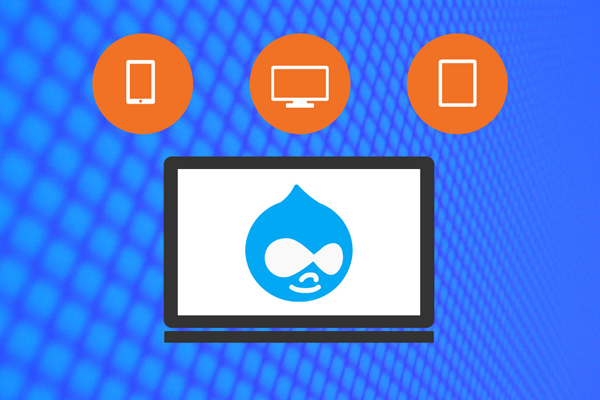With the proliferation in the touchpoints that enterprises use to connect with customers and provide them with the valuable experience, it’s has become a tedious and challenging task to optimize the content far and wide.
Further, the number of devices that consumers use to access brand content- desktops, mobile phones, laptops, tablets, and smartwatches - with yet more looming on the horizon; have their own set of restrictions and specifications which again increases the complexities of content creators & marketers in the dissemination of the personalized content.
Also, this Gartner Report suggested that marketers & decision-makers should now opt for a unified experience strategy to streamline their customer-facing content. This can be done through the implementation of the latest technology and channels to promote dynamic personalization and optimize content in an avant-garde manner. And all this can be executed by dint of Content-as-a-Service.
This blog provides further insights on CaaS, its use cases & features, and how enterprises and marketers can leverage Drupal as CaaS for managing their content efficiently.
What is Content as a Service?
Content-as-a-Service (CaaS) focuses on managing structured content into a unified repository or feed that other applications and properties consume.
The idea behind it is to provide a future-ready CMS that makes content readily available by employing API with or without developing the presentation tier. The presentation layer can be a website, a mobile app, or a feed into a device’s interface.
The idea behind it is to provide a future-ready CMS that makes content readily available by employing API with or without developing the presentation tier
This separation between the content itself and its presentation implies that RESTful APIs, for instance, can provide the same content that serves both your website to an iOS or Android app.
Put simply, it draws a clear line between the people creating the content, the people delivering the content, and of course, the people consuming it.
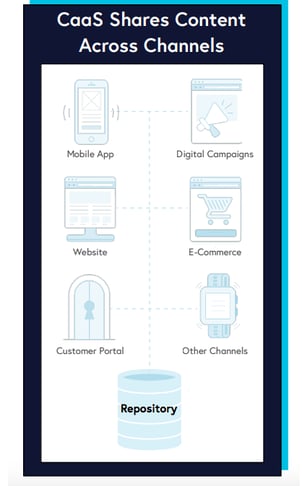
Source: Bloomreach
Characteristics of Content-as-a-Service solutions include:
-
The content disseminated across all channels via a Rest-based API
-
A method of developing content as per prescribed content models
-
Structured formats for returning content via simple queries.
-
Distributed authoring and workflow content administration
-
A content repository hosted in the Cloud for universal access
-
Triggers that alert customer experience applications that consume content to content updates
-
Metadata definitions that can be defined and move along with the content via API
How Does CaaS work?
The actual implementation of CaaS can vary as in the case with any architectural pattern but here is a general overview of how CaaS platform may work-
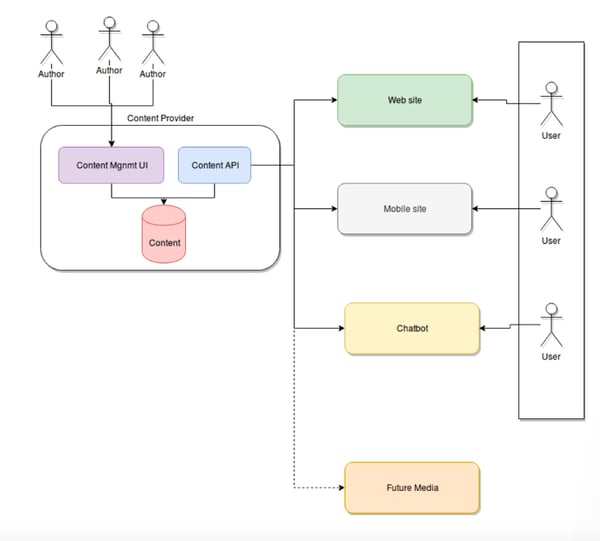
The content management UI is a web application to centralize all content authoring and content management of the platform. Content is placed inside centralized storage: it is to note that the format and technology used for the same does not matter at this point, what matters is the correct storage of data.
At last, the content is made available through a technology-agnostic API, like REST API. There are products available in the market which lets you author the content whilst working on the presentation layer to provide you with a wide array of applications you may need (for instance, web apps, mobile apps).
You could, as an alternative, also provide access to the public APIs of these platforms, allowing others to take care of building their own presentation layers and saving you the trouble of working on that.
Know how Srijan helps enterprises in modernizing their platforms to manage their content across various channels
Why CaaS?
Creating dedicated content for every specific medium becomes cumbersome to the point of being unworkable
Have you ever thought that how enterprises and marketers can tweak content for each one of the channels and yet ensure that the content is safe and sustainable for any modification in the future? Since it’s understood that creating dedicated content for every specific medium becomes cumbersome to the point of being unworkable.
So, how is it possible? The answer to this simple question is CaaS!
It can be efficient for enterprises those who want to upgrade their CMS either into one which can serve as CaaS or when there was nothing before.
However, the key deciding factor(s) at the end will be your current context. The reasons are mentioned below-
-
Siloed Content
Enterprise deals with an enormous amount of content and the sources from where it comes in and having to manage them independently can prove labor-intensive. Either company can spend a lot of time from their schedule to simply manage the content or spend too many resources having a team manager & a set of independent tools with the added overhead of getting them to collaborate with each other.
In either case, they are most likely dealing with one or maybe more of such situations:
-
They don’t own a uniform content format, which can be made use of for easy distribution.
-
They don’t own a centralized method to make content available for consumers, be they internal or external ones.
-
Metadata is not given due importance in empowering their content and making it rich for consumers.
-
And centralized storage, so, companies have to put extra efforts to move from one source of data to the next.
The adoption of CaaS could be beneficial to anyone looking desperately to switch their content management strategies. A switch to content-centric approach, i.e., Content-as-a-Service, would significantly improve their performance.
2. Limited formats for your content
Content has to be an abstract entity, and choosing the way how it should be consumed, should be your top priority
Your problem might not be about managing your content but inefficiency in reaching to the targeted consumers due to a restricted amount of formats you are compatible with. Content-as-a-Service is again the perfect solution for such kind of scenarios.
Many CMS, such as WordPress, take the responsibility for presentation ensuring that you don’t have to worry about it. However, you also get restricted to the number of devices with which representation of your content is compatible. There could be so many devices where your content can be rejected immediately or simply not pleasant to be consumed in. For instance, have you ever considered how will your online trading WordPress website will show stocks on your smartwatch? What about a VR headset? Or a holographic projection? Agreed that last one does not exist yet but you must ensure that the company is well-equipped and future-ready to be compatible with new technologies, especially when it is moving at breakneck speed and released to the public every day.
Even the new foldable phones are going to be accessible for the public now- what will happen then to the content?
Companies will limit their odds of success if they kept their content tied to their representation. Content has to be an abstract entity, and choosing the way how it should be consumed, should be your top priority
3. Native mobile app needing content
Content-as-a-Service provides you with the flexibility to use your content however you want, now or in the future
Since content display on mobile phones and apps demand extra attention, most of the traditional CMS fails to provide the necessary tools and facilities for the same. They only provide web-compatible formats (e.g., HTML) making it unfit for your app.
You can work around this by using a headless, decoupled CMS or Content-as-a-Service to simplify your work. In a nutshell, Content-as-a-Service provides you with the flexibility to use your content however you want, now or in the future.
What Drives the Adoption of CaaS?
There are two groups primarily that can leverage this type of content delivery the most: developers and business users/content creators.
- Developers
Developers do require CaaS no matter they are mobile app developers who need a backend to feed their apps with content or front-end developers who expect to interact with an API.
Such technologies have been around since long and widely accepted as well, further fueling the demand for CaaS.
2. Business-
Those content creators who want to increase the reach of their content to as many platforms and channels as possible- web, mobile, social networks, smart devices, and so on.
-
It becomes exorbitant to have a separate solution for every channel- development-wise and maintenance-wise.
-
It is convenient to manage a single editorial team and a single software stack for all channels.
-
CaaS solutions can help developers in being more productive and efficient with the tools they like to use.
CaaS Use Cases
It’s often perceived that there is no single CMS that is equally good for maintaining both a personal blog and a huge online shop. Contrary to the assumptions, CaaS outperforms its harbingers in some use cases-
CaaS focuses on pushing wherever and whenever required, designers need not worry anymore
-
Mobile apps content backend
Pushing content on a mobile app via CaaS proves as the most effective way to have dynamic in-app content without having the need to resubmit the app to the app marketplace.
-
Multi-channel publishing
CaaS CMS is also beneficial when content needs to be transmitted across various platforms, for example, you want to push the same content to a website as well as to mobile apps.
-
Rich Web apps
Modern view controller, i.e., front-end frameworks, such as AngularJS, React, and Ember synchronizes well with structured content via APIs.
-
Integrating with existing services and software stacks
CMS can considerably reduce the complexities and simplify workflows in an existing project, for instance, eliminating hard-coded content from HTML pages, and maintaining them with a CMS. In contrast, the API by CaaS makes it highly integration-friendly and robust.
-
Tailored UX
The CMS of web age posed strong design restrictions. Though you could fully tweak the UI but building a Wordpress-powered web app from scratch was not very likely.
On the other hand, as CaaS focuses on pushing wherever and whenever required, designers need not worry anymore!
-
Programmatic content creation
It becomes a tedious task to manage already existing content and also the one arriving from multiple sources. Therefore, it is best-suited to upload content into one unified repository by creating content via APIs.
-
Artificial intelligence and chatbots
Content structured via API makes it easy for AI-powered agents and chatbots to move it around and churn it for ensuring relevance than screen scraping and using natural language for processing unstructured content.
How Drupal Can Prove to Be An Effective CaaS?
Drupal has unfolded the idea of Content-as-a-Service (CaaS) to solve the dilemmas posed by our newfangled digital ecosystem & its extremely high demand for new and different types of content.
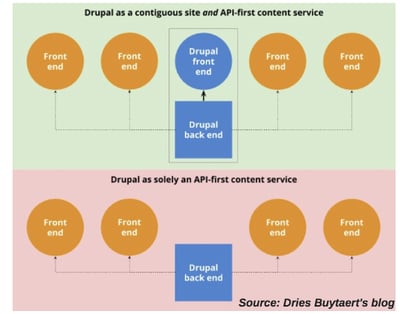
Following features on how Drupal can be an effective CaaS-
-
Reusable future-proof content
Drupal content can easily exist in the form of reusable chunks
Generally, CMSes manage content in a back-end repository and push it to the front-end templates for serving an experience.
However, Drupal decouples the back and front end whenever required. So, Drupal content can easily exist in the form of reusable chunks: free from the presentation and set for delivering content to sites and apps. Thus, content becomes future-ready.
-
Set front-end developers free to create a better experience
With Drupal’s presentation-neutral content and a RESTful API, front-end developers can freely carry out their creative vision and build interactive sites & apps with the tools like Node, Angular, Backbone, Ember and others.
-
Fill the content bucket more easily
Content nowadays should not be restricted to one source only rather it should move in and out freely. And Drupal helps in that by ingesting third-party content (e.g. from aggregators and syndicators) to bring content into your Drupal ecosystem and making it further easy to push to any site, app or channel.
-
Share content beyond your sites
Today, organizations want to share content on multi-channels where the audiences are inside of content aggregators disrupting the news business. Content teams need an optimal way to create content & then share it with minimal effort. And Drupal does that! The other sites and apps you choose can easily churn Drupal content.
-
Alter the look
The separation of backend content from front-end presentation gives a leading edge to developers to refine an experience without worrying about the content in the CMS.
Additionally, Drupal’s 8.0 version comes with an inbuilt REST API which marked its beginning of API-first initiative.
REST allows apps and websites to read and update information on the websites via the web. It also encourages developers to rely on HTTP methods to operate on resources managed by Drupal.
Furthermore, the Drupal community has been working on shipping Drupal modules with web service APIs instead of depending on a central API module in the upcoming releases of Drupal.
Contenta, one of the Drupal’s distributions, is an HTTP API provided for ready-to-use purpose with full auto-generated documentation. It offers modern API capabilities with JSON API, and also feeds content in the JS-driven websites, mobile applications, TV and even fridge applications.
Contenta supports Create Once, Publish Everywhere, be it single application development or multi-channel publishing.
Then there is another distribution, Reservoir, which helps in implementing the Decoupled Drupal architecture, is very flexible and simple-to-use for building content repositories of any application. It also helps in modeling content, governing content, and interacting with that content through HTTP APIs.
In a nutshell, Drupal’s API-first approach offers the following benefits which further bolsters CaaS model-
-
The decoupled approach separates the presentation layer from the service layer thus allowing a detailed and dedicated focus on each of them.
-
A foolproof approach to help organizations connect to infinite digital signages for enhancing customer experience
-
Increased interaction with customers on their preferred devices will eventually scale up your marketing efforts
-
The decoupled approach is flexible and open for changes, addition, and modification of the structure.
-
Deploying a front-end framework like Angular or React will lead to sophisticated, enriched and dynamic web experience
Learn more about Drupal API-first initiative from here-
Features to Lookout For in CaaS
CaaS comprises of three vital parts: the editing interface (typically a web app), the CMS infrastructure capabilities, and the development ecosystem.
Web editor
-
Enables content architects to design the structure of the content
-
Enables content editors to manage content from creating, updating to collaborating on it.
Technical infrastructure
-
Offers performance, uptime, and scalability to ensure that enterprises can rely on their vendor to deliver content in mission-critical applications.
-
SLAs with short incident response times and access to dedicated staff- so in case of a problem with a mission-critical app, companies can be provided back up again and fast.
-
Mobile delivery capabilities so that great user experience can be delivered even in network-challenged environments ( like subways, rural areas) and high bandwidth cost areas (such as emerging markets).
-
API-based importing, management, and delivery for controlling content programmatically in both ways
-
All-inclusive and up-to-date documentation to help the development team start using the tools quickly.
-
CDN ( content delivery network) to deliver the content rapidly
Development ecosystem
-
SDKs and libraries to increase the speed no matter what the tech stack is
-
Demo app source code so that developers don’t feel the need to reinvent the wheel all over.
-
Third-party integrations to obtain value from existing tools.
Other Characteristics of CaaS
The decoupled approach ensures that code and content are placed separately so that marketers and developers can do their respective work
-
Decoupled approach
The decoupled approach ensures that code and content are placed separately so that marketers and developers can do their respective work. Teams can also work parallelly on a creative copy, enticing visuals, and expert integrations in one unified platform.
-
Separation of content and presentation
This is the quintessence of the headless CMS approach - agnosticism towards how content is presented. This frees developers from creating highly custom front-ends and apps since they get to define the content display part.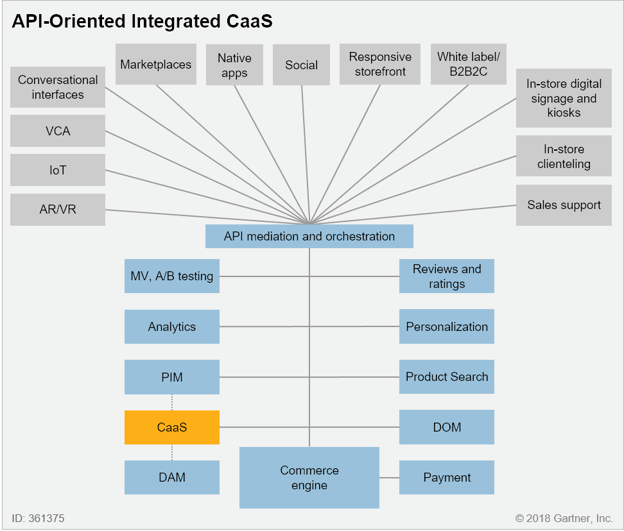 Source: Gartner
Source: Gartner
-
Cloud setup
The complete separation of the content management and display part allows organizations to migrate infrastructure between Cloud and hybrid, even at the site level or project level. Some projects can be installed locally while some on Cloud depending on the business’ choices for optimization as per needs.
-
Insights
Centralized Content-as-a-Service lets businesses evaluate the content consumption across the digital ecosystem. This ceases businesses from duplicating their efforts and content when posting to microsites, international sites, or apps. It can also measure the use of that content by looking at the API connections used to deliver that content, and keeping track of where the content is going.
In the End
The digital revolution and breakthrough in technology have accelerated the efforts of content creators - be it creation, designing, or dissemination. The goal is clear- refined user experience.
With that said, the creation of content in abundance and its delivery as a service through thousands of APIs will generate more data thereby assisting content developers to create more precise business models.
The technology is already in place, and the architectural patterns will allow enterprise systems to scale up without hampering their performance.
Content-as-a-Service ensures that developers are rendered maximum freedom and flexibility to realize their digital innovation. Drupal as a CaaS has been delivering a wonderful experience to both content editors and developers alike.
It is definitely a convenient way to ensure that your strategy is future-proof and can handle any new media in the future.
Our Services
Customer Experience Management
- Content Management
- Marketing Automation
- Mobile Application Development
- Drupal Support and Maintanence
Enterprise Modernization, Platforms & Cloud
- Modernization Strategy
- API Management & Developer Portals
- Hybrid Cloud & Cloud Native Platforms
- Site Reliability Engineering


